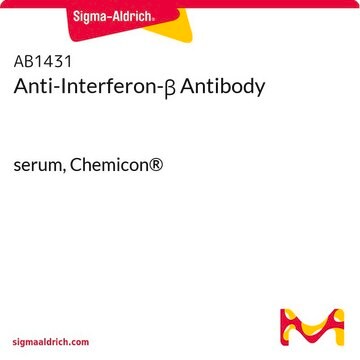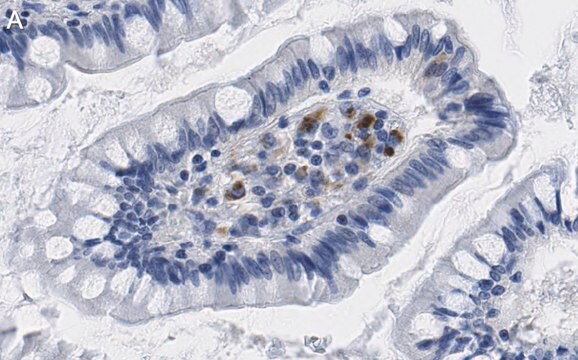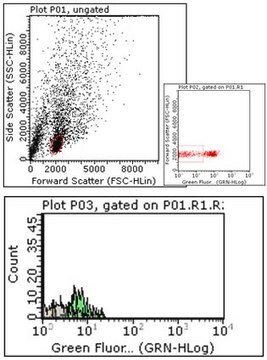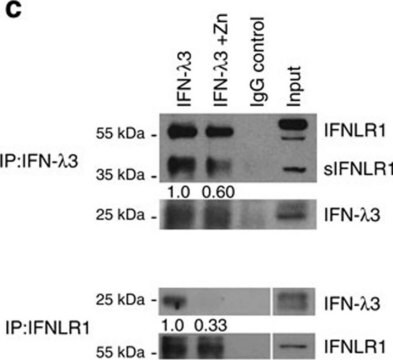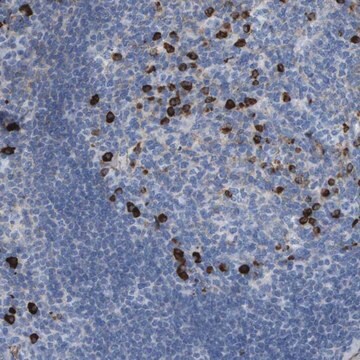I4902
Anti-Interferon-α/β Receptor 1 antibody produced in goat
affinity isolated antibody, lyophilized powder
Synonym(s):
Anti-IFN-α/β R1
Sign Into View Organizational & Contract Pricing
All Photos(1)
About This Item
Recommended Products
biological source
goat
Quality Level
conjugate
unconjugated
antibody form
affinity isolated antibody
antibody product type
primary antibodies
clone
polyclonal
form
lyophilized powder
species reactivity
human
technique(s)
flow cytometry: suitable (1-10μg/106 cells)
western blot: 0.1-1 μg/mL
UniProt accession no.
storage temp.
−20°C
target post-translational modification
unmodified
Gene Information
human ... IFNAR1(3454)
General description
Interferon-α/β Receptor 1 is a dimeric, disulfide-linked protein that binds human interferons α and β. This receptor also interacts with Tyr kinase JAK1, and thereby regulates cellular signaling across the membranes . Anti-Interferon-α/β Receptor 1 is specific for recombinant human IFN-α/β R1 and does not react with recombinant human IFN-γ RI and IFN-γ RII.
Immunogen
recombinant human IFN-α/β R1 extracellular domain expressed in Sf21 insect cells.
Application
Anti-Interferon-α/β Receptor 1 antibody is suitable for usein flow cytometry (1-10μg/106 cells) and western blot (0.1-1 μg/mL). Theantibody may also be used for immunoblotting (approx. 135kDa) and indirectimmunofluorescence (using appropriate secondary antibodies).
Physical form
0.1-1 μg/mL Recombinant Human IFN-α/β R1, HeLa humancervical epithelial carcinoma cell line, K562 human chronic myelogenousleukemia cell line.
Disclaimer
Unless otherwise stated in our catalog or other company documentation accompanying the product(s), our products are intended for research use only and are not to be used for any other purpose, which includes but is not limited to, unauthorized commercial uses, in vitro diagnostic uses, ex vivo or in vivo therapeutic uses or any type of consumption or application to humans or animals.
Not finding the right product?
Try our Product Selector Tool.
Storage Class Code
13 - Non Combustible Solids
WGK
WGK 1
Flash Point(F)
Not applicable
Flash Point(C)
Not applicable
Choose from one of the most recent versions:
Already Own This Product?
Find documentation for the products that you have recently purchased in the Document Library.
S N Constantinescu et al.
Proceedings of the National Academy of Sciences of the United States of America, 91(20), 9602-9606 (1994-09-27)
A previously cloned cDNA encodes one subunit of the human interferon alpha/beta receptor (IFN alpha R), denoted IFN alpha R1. To study the expression and signaling of IFN alpha R1, we used monoclonal antibodies (mAbs) generated against the baculovirus-expressed ectodomain
D Novick et al.
Cell, 77(3), 391-400 (1994-05-06)
We describe a universal ligand-binding receptor for human interferons alpha and interferon beta (type I IFNs). A soluble 40 kDa IFN-alpha/beta receptor (p40) that blocks the activity of type I IFNs was purified from urine and sequenced. Antibodies raised against
Ashraful Haque et al.
The Journal of clinical investigation, 124(6), 2483-2496 (2014-05-03)
Many pathogens, including viruses, bacteria, and protozoan parasites, suppress cellular immune responses through activation of type I IFN signaling. Recent evidence suggests that immune suppression and susceptibility to the malaria parasite, Plasmodium, is mediated by type I IFN; however, it
Alana W Sullivan et al.
Endocrinology, 155(10), 3867-3881 (2014-07-23)
Impacts on brain and behavior have been reported in laboratory rodents after developmental exposure to bisphenol A (BPA), raising concerns about possible human effects. Epidemiological data suggest links between prenatal BPA exposure and altered affective behaviors in children, but potential
S M Francis et al.
Brain research, 1580, 199-218 (2014-01-28)
Oxytocin (OT) and arginine vasopressin (AVP) are two small, related neuropeptide hormones found in many mammalian species, including humans. Dysregulation of these neuropeptides have been associated with changes in behavior, especially social interactions. We review how the OT and AVP
Our team of scientists has experience in all areas of research including Life Science, Material Science, Chemical Synthesis, Chromatography, Analytical and many others.
Contact Technical Service